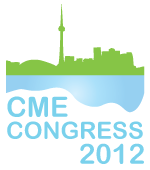France St-Germain (Sanofi Canada); Alan Bell (University of Toronto); Martin Robert (HIT Global Consulting Services Inc.); Stephanie Bedasse (HIT Global Consulting Services Inc.)
Synopsis
The REACH Academy II program, an interactive simulation activity, was developed to facilitate the knowledge transfer and implementation of the new clinical guidelines in family practice. The simulation format allowed authors to highlight nuances in clinical decisions and provide practical guidance to clinicians. It also allowed them to provide an objective means of assessing clinician comprehension and performance.
Abstract
Purpose: The objective of the REACH Academy II program was to facilitate the knowledge transfer and implementation of the new Canadian Cardiovascular Society antiplatelet guidelines in family practice.
Methods
Targeted case simulations based on practical clinical scenarios were created to demonstrate new guideline recommendations in practice. Teams comprising a minimum of 4 clinicians were recruited to complete the interactive case-based simulation program. To allow physicians to select their preferred learning medium, the program was offered both in live and e-learning formats. After completing a pretest, participants selected from 8 clinical vignettes which addressed key aspects of the guidelines. Each case included multiple decision points to encourage interaction and reflection. Following the event or online session, participants completed an evaluation form as well as a post-test. Results of the post-test were provided to participants to encourage reflection following completion of the vignettes.
Results
The results are expected to demonstrate that physicians will appropriately implement the new Canadian Cardiovascular Society antiplatelet guidelines in their everyday practice as assessed by the simulation program. By distributing the program through live and online formats, we were able to extend the reach of the program as well as provide multiple channels for physicians to interact with the content – reinforcing the messages taught.
Conclusions
Interactive case simulation activities provide guideline authors a powerful tool to promote the integration of new guidelines in practice. Simulations allow authors to highlight nuances in clinical decisions and provide practical guidance to clinicians. Simulations also provide an objective means of assessing clinician comprehension and performance.
Declaration
Dr. Bell has received research, consulting, or speaker honoraria from the Canadian Cardiovascular Society, Thrombosis Interest Group of Canada, AstraZeneca, Sanofi, Bristol-Myers Squibb, and Bayer. Ms. St-Germain is an employee of Sanofi.





